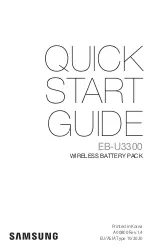
3
SYMBOLOGY
Volts
Direct Current
Alternating Current
Double Insulated
Hertz
Amps
Properly Recycle Batteries
C
US
UL Listing for Canada and U.S.
FUNCTIONAL
DESCRIPTION
1. Contacts
2. Release buttons
3. Fuel Gauge button
4. Fuel Gauge
5. Electrical contacts
6. Bay
7. Vents
8. Light indicators -
when a battery pack is inserted into the charger,
the light will indicate the following:
Continuous red: Charging
Continuous green light: Charging is complete
Flashing red: Battery is too hot/cold -
Charging will begin when battery
reaches correct charging
temperature
Flashing red/green: Damaged or faulty
battery pack
5
7
8
6
2
2
1
4
3
SPECIFICATIONS
Charger Cat. No. ...............................48-59-2819*
AC Input Volts
....................................................
120
AC Input Amps..................................................
2.75
DC Output Volts
...................................................
28
DC Output Amps.................................................3.5
Battery Cat. No.................................... 48-11-2830
DC Volts
...............................................................
28
Charge Time .................................................1-Hour
Operating Temperature
Battery and Charger ....................
32°F to 150°F
(0°C to 65°C)
Battery and Tool ................................
0°F to 167°F
(-18°C to 75°C)
*Charges
MILWAUKEE 48-11-2830 M28
™
and
48-11-2830 V28
®
Li-Ion battery packs.
MILWAUKEE
LITHIUM-ION
BATTERY PACKS
Fuel Gauge
Use the Fuel Gauge to determine the battery pack's
remaining run time. Press the Fuel Gauge button
to display the lights. The Fuel Gauge will stay lit for
two seconds.
NOTE:
If the Fuel Gauge
78-100%
55-77%
33-54%
10-32%
<10% - 1st light will flash 4X
0% - 1st light will flash 8X
Approximate Run
Time Remaining
doesn't appear to be work-
ing, place the battery pack
on the charger and charge
as needed.
Compared to NiCd battery
pack types, MILWAUKEE
Lithium-Ion battery packs
deliver fade-free power for their entire run time. The
tool will not experience a slow, gradual loss of power
as you work. To signal to you that the battery pack is
at the end of its run time and needs to be charged,
power to the tool will drop quickly. When this hap-
pens, remove the tool from the workpiece and charge
the battery pack as needed.
NOTE:
Immediately after using the battery pack,
the Fuel Gauge may display a lower charge than it
will if checked a few minutes later. The battery cells
"recover" some of their charge after resting.
Battery Pack Protection
To protect itself from damage and extend its life, the
battery pack’s intelligent circuit monitors current draw
and temperature.
In extremely high torque, binding, stalling, and short
circuit situations, the battery pack will turn OFF the
tool if the current draw becomes too high. In these
situations, the tool may “buzz” for about 2 seconds
before it turns OFF. To prevent the tool from turning
OFF, immediately reduce pressure on the applica
-
tion or release the trigger. If the tool does turn off,
the Fuel Gauge lights will flash 8 times. Release the
trigger to reset.
Under extreme circumstances, the internal tem
-
perature of the battery could become too high. If this
happens, the battery pack will shut off. When the Fuel
Gauge button is pressed, the lights will flash alternat
-
ingly. Allow the battery pack to cool. The battery is ready
for use when the Fuel Gauge displays the remaining
run time when the Fuel Gauge button is pressed.























